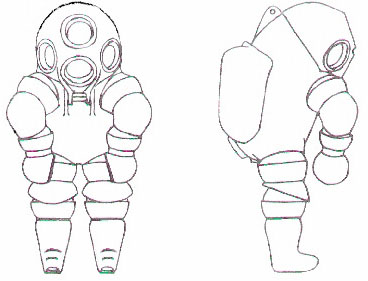
Courtesy of Mike Humphrey
At about this time our company received a contract, to build our first complete suit, which we named JIM after Jim Garrett who was the first diver to test the old Peress Tritonia suit. This suit featured different style joints.
|
|
We completed the first suit in November 1971. A short while later we moved the suit to the Royal Navy test tank at HMS Vernon at Portsmouth. The Navy also allowed us access to their pressure chamber at the Admiralty Underwater Weapons Establishment at Portland in Dorset. Here we made the first manned test dives to one thousand feet. As a result of the success of these trials we were offered the opportunity of diving in deep water using HMS Reclaim, the Royal Navy salvage vessel. These trials took place off the west coast of Scotland and we made a number of dives to about four hundred feet. This was the maximum depth that the Reclaim divers could reach in case of emergency.
|
|
Commercial diver Vic Johns from Devon England has a lot of
experience in the old JIM suit.
He wrote to us: "Here's a picture of me and my JIM suit (taken in 1973), with original spherical turned joints. These joints had a very nasty habit of grabbing your inner thighs and pinching them, leaving you with enormous blood blisters, always a laugh for the topside crew when they heard you scream but not a pleasant experience for the guy inside the suit." |
|
He continues: This JIM suit (# 4 from 1974) is fitted with the type two leg joints and type three arm joints, making movement just a little better than the original. The JIM suits carried
(in theory depending on whether there was a haske pump on board the work
vessel.) 72 hours of oxygen externally on the rear of the suit. This fed a
twin hose oral nasal bib, two soda lime scrubbers with a change over
switch. Situated behind the operator an O2 alarm and depth
|
|
|
|
|
|
The thruster unit for JIM
Photo courtesy of Mike Humphrey.
|
Early
JIM versions could go up to 300 meters and had 8 oil supported universal joints. The oil formed a perfect
watertight seal and ensured movability. The experimental "hands" on the ends of the
first production JIM were replaced with the more practical pinchers on all the
following suits. In case of an emergency this umbilical could be disconnected. Also the weights on the outside of JIM that assure negative buoyancy can be dropped by the diver so JIM will float to the surface. JIM was engaged in numerous successful diving jobs, especially in the off shore oil business. Over the years modifications were made to JIM. The joints were replaced with others that allowed greater movability. The four portholes were replaced with a large acrylic dome. Depth limits now go to about 500 meters. This newer suit is known as JIM IV series. |